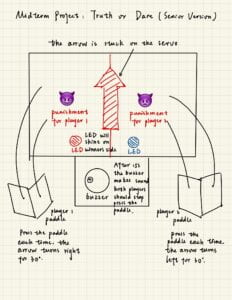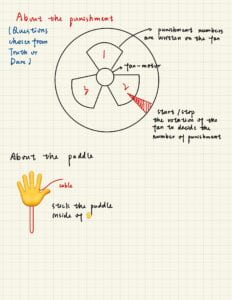Step 1: Build the circuit
I followed the circuit picture given and built the circuit. Luckily, the wiring was correct, and we programmed Arduino with the example code. We found the motor rotated smoothly and made one revolution.
Step 2: Build a cardboard mechanism!
In step 2 we need to build the cover of the machine with cardboards. We spent most of the time cutting the cardboard and glueing it together. Then, we connected the DC motor to the artifact. Finally, with our joint effort, we made it, and we drew a cube and stuck it to the motorized arm.
Step 3: Personalize it
Finally, we tried to change the rotation speed, degree and the delay to make it spin faster. This is the step where we met with difficulties. We found that every time we tried to increase the value in the code, the motor would stop spinning and only make noise. Then we asked the instructor, and surprisedly found that we should connect a wire with a larger voltage in order to run the motor. We eventually made the motor spin faster.
Additional Questions
Question 1: Choose an art installation mentioned in the reading ART + Science NOW, Stephen Wilson (Kinetics chapter). Post your thoughts about it and make a comparison with the work you did during this recitation. How do you think that the artist selected those specific actuators for his project?
The art installation: Ken Rinaldo and Matt Howard, Autotelematic Spider Bots, 2006
This art installation integrates the features of ants and spiders. It can interact with visitors and communicate with electrical recharge ports to learn from artificial-life behaviors. I think the art installation may use some rotating mechanism in its movements. In our recitation class, the artifacts we made uses the motor to spin and rotate, which may similar in the art installation. Converting energy into lots of motion, this art installation is really amazing!
Question 2: What kind of mechanism would you be interested in building for your midterm project? Explain your idea using a sketch (conceptual or technical) with a list of materials that you plan to use. Include details about the ways that you expect the user to embrace in a physical interaction with your project. In particular, explain how would your motor (or motors) with a mechanism will be different than using an animation on a digital screen.
In my midterm project, we plan to use servo and DC motor to add the rotating mechanism. The material we will use: laptop, servo, LEDs, cables, DC motor, buzzer, cardboard, mini fan, resistors, transistor, breadboard, Arduino set. We use the clapping toy instead of the switch to control the direction of the arrow. When the game begins, the LED lights up, the buzzer makes a sound as a signal, and players on both sides compete speed with the clapping toy. When game is over (after 15 seconds), the player who is pointed by the arrow should accept the punishment — Truth or Dare. We plan to stick Truth or Dare questions on the small fan to decide the question as punishment. We try to add more fun elements to this game by adding a speed contest and using random to compete for luck, which adds more fun to this game between two players.

